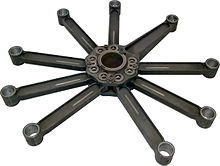Register now or log in to join your professional community.

#3 is the top part of the Rod Bearing.

A rod bearing is a two-piece (top and bottom) band of smooth metal. In the case of driveshaft rod bearings, for example, the top half of the bearing is a semi-circle that is mounted to the undercarriage of the vehicle. The bottom half of the bearing is bolted to the top half once the driveshaft is in place. A pinhole through the top half of the bearing allows lubrication to reach the inside. This permits the shaft to spin within the bearing without generating excessive heat.Read more : http://www.ehow.com/info_8719687_rod-bearings.html

I agree with you'r answer Mr. Alex ... Thanks

Many-cylinder multi-bank engines such as a V12 layout have little space available for many connecting rod journals on a limited length of crankshaft. This is a difficult compromise to solve and its consequence has often led to engines being regarded as failures (Sunbeam Arab, Rolls-Royce Vulture).
The simplest solution, almost universal in road car engines, is to use simple rods where cylinders from both banks share a journal. This requires the rod bearings to be narrower, increasing bearing load and the risk of failure in a high-performance engine. This also means the opposing cylinders are not exactly in line with each other.
In certain engine types, master/slave rods are used rather than the simple type shown in the picture above. The master rod carries one or more ring pins to which are bolted the much smaller big ends of slave rods on other cylinders. Certain designs of V engines use a master/slave rod for each pair of opposite cylinders. A drawback of this is that the stroke of the subsidiary rod is slightly shorter than the master, which increases vibration in a vee engine, catastrophically so for the Sunbeam Arab.
 BMW132 radial aero engine rods
BMW132 radial aero engine rods
Radial engines typically have a master rod for one cylinder and multiple slave rods for all the other cylinders in the same bank.
 Fork and blade rods
Fork and blade rods
The usual solution for high-performance aero-engines is a "forked" connecting rod. One rod is split in two at the big end and the other is thinned to fit into this fork. The journal is still shared between cylinders. The Rolls-Royce Merlin used this "fork-and-blade" style. A common arrangement for forked rods is for the fork rod to have a single wide bearing sleeve that spans the whole width of the rod, including the central gap. The blade rod then runs, not directly on the crankpin, but on the outside of this sleeve. The two rods do not rotate relative to each other, merely oscillate back and forth, so this bearing is relatively lightly loaded and runs as a much lower surface speed. However the bearing movement also becomes reciprocating rather than continuously rotating, which is a more difficult problem for lubrication.
A likely candidate for an extreme example of compound articulated rod design could be the complex German24-cylinder Junkers Jumo222 aviation engine, meant to have — unlike an X-engine layout with24 cylinders, possessing six cylinders per bank — only four cylinders per bank, and six banks of cylinders, all liquid-cooled with five "slave" rods pinned to one master rod, for each "layer" of cylinders in its design. After building nearly300 test examples in several different displacements, the Junkers firm's complex Jumo222 engine turned out to be a production failure for the more advanced combat aircraft of the Third Reich's Luftwaffe which required aviation powerplants of over1,500 kW (2,000 PS) output apiece.





Do you need help in adding the right keywords to your CV? Let our CV writing experts help you.